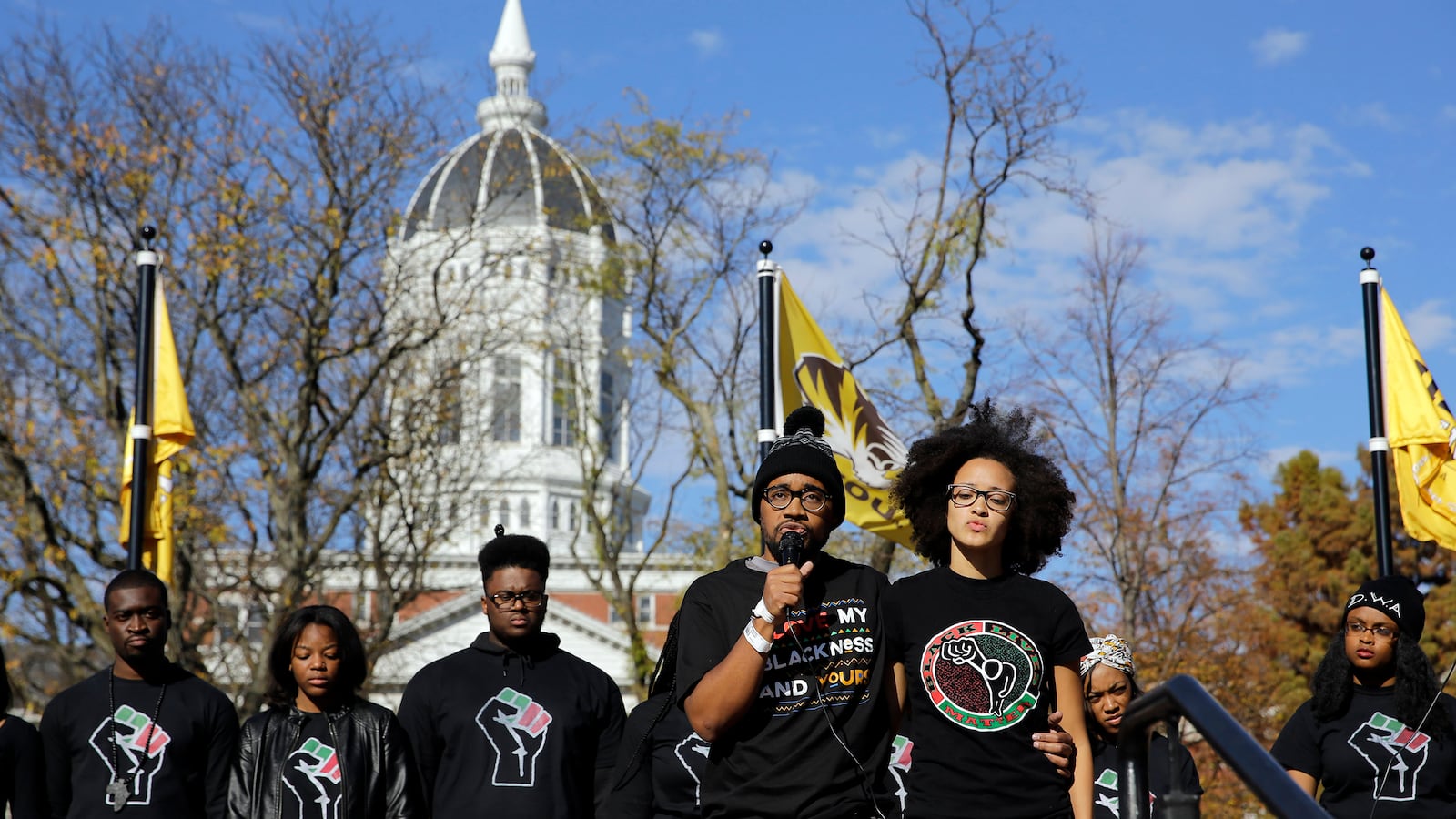A new dawn is rising over a small college town in central Missouri.
There, Jonathan Butler is enjoying his first meal since beginning a hunger strike that captured national headlines. The Missouri Tiger team will suit up for its first practice since staging a walkout supported by its coach. University professors, who supported the strike, will return to their classrooms just a day after announcing their solidarity.
Together, buoyed by a football team that threatened to upend a billion-dollar economy, the unlikely coalition pushed two university leaders from their posts in the name of social justice.
On Monday, after weeks of student-led protests over reported racial strife and a demand for his ouster, embattled university president Tim Wolfe resigned. Hours later, the chancellor also stepped down. In the midst of racially fueled upheaval, Bowen Loftin told reporters that he would transition to a new role advancing research at the start of the new year.
Change is finding its footing in Columbia, Missouri. Though to understand what happened at the state’s largest university in recent days, to understand how and why students and faculty challenged the strictures of race and class in this moment, you must go back further than the last 72 hours.
What one believes about a story depends on where one believes it began and this story stretches back more than 50 years to when 18-year-old Norris Stevenson suited up and stepped onto the football field in 1957.
You have to go back to when the marching band was still playing “Dixie” to celebrate every touchdown—the days when Stevenson hustled to the sideline and watched as a fraternity triumphantly waved a Confederate flag with every goal.
The husky fullback, a St. Louis native who graduated from Vashon High School, was the first black student athlete to attend the University of Missouri-Columbia on a full football scholarship. It is hard to know if or how it affected his game day performance, but Stevenson ended his collegiate career in 1960 with 1,174 rushing yards and 10 touchdowns, vaulting the Tigers to its first and last outright No. 1 spot in the Big Eight Championship. (He later went on to play in the NFL.)
Back home in St. Louis–a two-hour drive over Interstate 70—there were few places his family could live, few restaurants that would afford them service, and there were even fewer places he could go after dark. St. Louis, one of the most segregated cities in America—then and today—was a house he could not truly call home. Despite a Supreme Court ruling three years prior, Stevenson—like my mother and me—was among the “colored” students and went to one of three segregated high schools—Sumner, Vashon, or Soldan, all situated on the near northside.
I cannot help but believe that Stevenson—who passed away in March of 2012—is singing a new song. He is not alone.
Between then and now, there was a drum major named Warren Bass—who also hailed from St. Louis. Bass arrived in 1961, when the band was still strumming “Dixie” after every touchdown. Both gay and black, Bass turned in glorious performances that were chronicled in black newspapers of the day and he was even featured in Ebony magazine. He was “absolutely gracious,” his classmate Beverly Clevenger told me on Monday, “one of the most gracious men I have ever known.”
“One day I picked up a broomstick and started clowning around with it,” Bass told Ebony in its January 1963 issue. Bass, who later went on to become a model in New York and lost his battle to AIDS in 1990 at age 47, said, “Then I watched a twirler in a parade, and I was fascinated. I decided I was going to learn to twirl.”
“He could literally throw that baton higher than the press box,” fellow twirler Clevenger said. “What a show person he was, but he was a humble.”
Clevenger, who grew up in Excelsior, Missouri, some 25 miles outside of Kansas City, and often lunched with Bass, said, “I don’t know how that set with the others on the squad. He had a lot of hopes and dreams. I had so much admiration for him. He would be alone in the student union.”
When she had trouble adjusting to new routines, Clevenger—who is white—said Bass was ready with a helping hand.
“I can see you’re having trouble with this,” he told her. “We will figure out what you need to do.”
Though, even as he spun his baton before a stadium packed with 25,000 football fans, Bass was quietly mounting a movement that would outlive his years. He hated “Dixie” and vowed to stop the band from playing the song. He held secret meetings with other black students and took his concerns to the band coach, who sided with him but did not have the political leverage to make the change. It was not until three years after Bass graduated that the tradition ended.
During a football game, a young undergraduate student named Harold Holiday—the first African American to be elected to student government leadership—quietly unfurled a black liberation flag. State troopers descended on Holiday immediately and escorted him and his fellow activists from the bleachers. It was there, in that moment, that the Legion of Black Collegians was formed—the very same student group that would lead the charge to remove the university president 47 years later.
Retired educator and Mizzou alum Jacqueline Moore, who graduated in 1967, returned to her alma mater and was there the fateful Saturday afternoon. Listening to her retell the story, in the living room of her Central Park West apartment in New York, was like walking both back and forward through history. I could hear the wind whistling in my ears.
But, if you close your eyes long enough, open your heart wide enough, you can almost see a drum major’s baton or a leather football twisting and floating in a perfect arc over history until it landed in the hands of Jonathan Butler.






